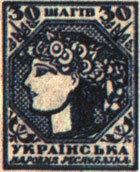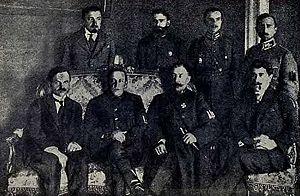Ukrainian People's Republic
|
|||||||||||||||||||||||||||||||||||||||||
The Ukrainian People's Republic (Ukrainian: Українська Народна Республіка, Ukrayins’ka Narodna Respublika; also translated as the Ukrainian National Republic, abbreviated UNR (УНР), in order to distinguish it from communist People's Republics) was a republic in part of the territory of modern Ukraine after the Russian Revolution, eventually headed by Symon Petliura.
Contents |
Tsentralna Rada
The socialist-dominated Tsentralna Rada was established on March 17, 1917, shortly after the start of the February Revolution (rada meaning "council", the equivalent of the Russian soviet). Its president was the respected historian Mykhailo Hrushevsky. During fighting in Kiev between supporters of the Russian Provisional Government and the Bolsheviks, the Tsentralna Rada threw its support behind the Bolsheviks. After expelling the government forces, the Rada announced an autonomous Ukrainian Republic, still maintaining ties to Russia, on November 22, 1917. After a brief truce, the small Bolshevik faction organized an All-Ukrainian Council of Soviets in December 1917 in an attempt to seize power. When this failed due to the Bolsheviks' relative lack of popularity in Kiev, they moved to Kharkiv and proclaimed a Ukrainian Soviet Socialist Republic. The Russian Bolshevik Red Army entered Ukraine in support of the Soviet government.
On January 25, 1918, the Tsentralna Rada issued its Fourth Universal (dated January 22, 1918), breaking ties with Bolshevik Russia and proclaiming a sovereign Ukrainian state. Less than a month later, on February 9, 1918, the Red Army seized Kiev.
Besieged by the Bolsheviks and having lost much territory, the Rada was forced to seek foreign aid, and signed the Treaty of Brest-Litovsk as an ally of the German Empire on February 9, 1918. Germany forced the Bolsheviks out of Ukraine, but by this time much of the Ukrainian population was disenchanted with the once-popular Rada. In the wake of internal squabbles and ineffective control of the countryside, the Germans disbanded the Tsentralna Rada on April 29, 1918. Prior to this, the Rada had approved the Constitution of the Ukrainian People's Republic.
Hetmanate

In the coup, the Rada was replaced by a conservative government of Hetman Pavlo Skoropadsky, the Hetmanate, and the Ukrainian People's Republic by a "Ukrainian State" (Ukrayins’ka derzhava). Skoropadsky, a former officer of the Russian Empire, established a regime favoring large landowners and concentrating power at the top, although it was merely a puppet of Germany. The government had little support from Ukrainian activists, but unlike the socialist Rada, it was able to establish an effective administrative organization, established diplomatic ties with many countries, and concluded a peace treaty with Soviet Russia. In a few months, the Hetmanate also printed millions of Ukrainian language textbooks, established many Ukrainian schools, two universities, and the Ukrainian Academy of Sciences.
The Hetmanate government also supported the confiscation of previously-nationalized peasant lands by wealthy estate owners, often with the help of German troops. This led to unrest, the rise of a peasant partisan (guerrilla) movement, and a series of large-scale popular armed revolts. Negotiations were held to garner support from previous Rada members Petliura and Vynnychenko, but these activists worked to overthrow Skoropadsky.
Due to the impending loss of World War I by Germany and Austria-Hungary, Skoropadsky's sponsors, the Hetman formed a new cabinet of Russian Monarchists and committed to federation with a possible future non-Bolshevik Russia. In response, the Ukrainian socialists announced a new revolutionary government, the Directorate, on November 14, 1918.
Directorate
-
 The Government of UNR 1920 - Symon Petlura sitting in the centre.
The Government of UNR 1920 - Symon Petlura sitting in the centre.
|
The Directorate gained massive popularity, and the support of some of Skoropadsky's military units including the Sich Riflemen. Their insurgent army encircled Kiev on November 21. After a three week long stalemate, the German forces withdrew, taking along Skoropadsky. On December 19, 1918, the Directorate took control of Kiev.
The Bolsheviks invaded Ukraine from Kursk in late December 1918. On January 22, 1919, the Directorate was officially united with the West Ukrainian People's Republic, although the latter entity de facto maintained its own army and government. In February 1919, the Bolsheviks captured Kiev.
Throughout 1919, Ukraine experienced chaos as the armies of the Ukrainian Republic, the Bolsheviks, the Whites, the Entente, and Poland, as well as anarchist bands such as that of Nestor Makhno vied for power. The subsequent Kiev Offensive, staged by the Polish army and allied Ukrainian forces, was unable to change the situation, and in March 1921, the Peace of Riga sealed a shared control of the territory by Poland, the Russian SFSR, and the Ukrainian RSR.
As the result, the lands of Galicia (Halychyna), the western part of the traditional territory of Ukraine, as well as a large part of the Volhynian territory had been incorporated into Poland, while the larger central parts of traditional Ukrainian territory, as well as predominantly Russian eastern and southern areas became part of Soviet Ukraine.
After its military and political defeat, the Directorate continued to maintain control over some of its military forces. Preempting a planned invasion by its rival Archduke Wilhelm of Austria, [1] in October 1921 the Ukrainian National Republic's government-in-exile launched a series of guerrilla raids into central Ukraine that reached as far east as Kiev Oblast. On November 4, the Directorate's guerrillas captured Korosten and seized much military supplies. But on November 17, 1921, this force was surrounded by Bolshevik cavalry and destroyed.
In 1922, having secured its territory, Soviet Ukraine joined the Russian, Byelorussian, and Transcaucasian republics to form the Union of Soviet Socialist Republics.
International recognition
The Ukrainian People's Republic was recognized de jure by Soviet Russia, Latvia, Lithuania, Estonia, Georgia, Azerbaijan, Germany, Austria-Hungary, Bulgaria, Turkey, Romania, Czechoslovakia, and the Holy See. De facto recognition was granted by Switzerland, Sweden, Denmark, and Persia.[2]
Maps of the Ukrainian People's Republic
See also
- West Ukrainian National Republic
- History of Ukraine
- Ukraine after the Russian Revolution
- Belarusian National Republic
- People's Republic
Notes
- ↑ Timothy Snyder (2008). Red Prince: the Secret Lives of a Habsburg Archduke. New York: Basic Books, pp.138-148
- ↑ (Talmon 1998, p. 289)
References
- Kubijovyč, Volodymyr (ed.) (1963). Ukraine: A Concise Encyclopædia Vol. 1. Toronto: University of Toronto Press. ISBN 0-8020-3105-6.
- Magosci, Paul Robert (1996). A History of Ukraine. Toronto: University of Toronto Press. ISBN 0-8020-7820-6.
- Subtelny, Orest (1988). Ukraine: A History. Toronto: University of Toronto Press. ISBN 0-8020-5808-6.
- Talmon, Stefan (1998). Recognition of Governments in International Law. Oxford University Press. ISBN 0-19-826573-5.
|
|||||||||||


